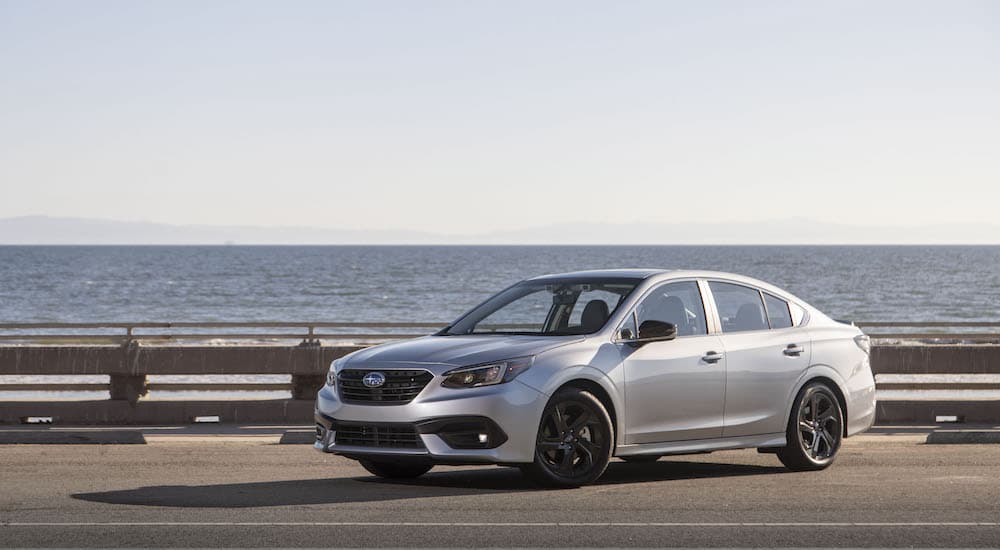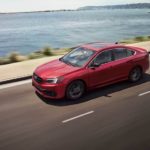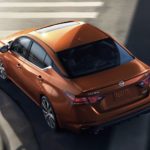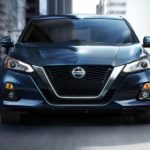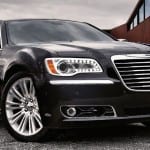How do you define a legacy? For many, a legacy is a lasting impact on the world, be it through financial success, pioneering ideas, or something else. However, the word “legacy” holds greater meaning for Subaru, denoting the automaker’s first American-built sedan meant to compete against Honda and Toyota.
Your search for a used Subaru Legacy might’ve been inspired by the sedan’s popularity and signature features, like its standard Symmetrical All-Wheel Drive and Boxer engine. Yet, the Legacy offers far more than Subaru’s well-known calling cards. Here’s everything the Legacy stands for in the Subaru lineup and why we have it to thank for other best-sellers like the Outback and Forester.
From Aircraft to Automobiles
Decades before the Subaru Legacy‘s debut, the company opened its doors in 1915 as the Aircraft Research Laboratory. Over the next several decades, it became one of the leading aircraft manufacturers in Japan, lending its efforts to World War II before it was reorganized as Fuji Sangyo Co. Under the new name, the company expanded into a dozen smaller corporations, tasking each entity with unique focuses like manufacturing engines, building chassis, and producing scooters.
Subaru 360
Subaru was among these companies and entered the automotive industry with the debut of the short-lived Subaru 1500, of which only 20 were produced in 1954 due to supply chain issues. A few years later, Subaru debuted the air-cooled 360 as an inexpensive economy car known for being “cheap and ugly.” Officially branded as a “Kei car” in the United States, the 360 minicar left much to be desired, even with its far more affordable price tag than rivals like the Volkswagen Beetle.
Subaru FF-1 and Leone Series
The Subaru 360 failed to impress, giving the automaker an inauspicious start in the fiercely competitive American automotive landscape. Fortunately, Subaru wasted little time and followed up with the FF-1, the first front-wheel drive car available in Japan. But the FF-1 was so much more than that.
Available as a coupe or sedan, the FF1 subcompact immediately distinguished itself with its unique horizontally opposed, water-cooled four-cylinder engine. The Boxer engine quickly became Subaru’s calling card and found its way under the hood of subsequent models like the Leone series (DL/GL models) that replaced the FF1 in the early 1970s. Around this time, Subaru upped the ante yet again.
Subaru 4WD Wagon
Building on the success of the DL and GL of the Leone series, Subaru introduced its four-wheel drive system on the 1975 4WD Wagon, which would go on to be the Symmetrical All-Wheel Drive system we know from 1987 onward. The DL and GL had already proven their capability, courtesy of the Boxer engine driving the front wheels, which was a novelty at the time. The 4WD Wagon took that to the next level and made history as the first four-wheel drive passenger car sold in America. Subaru gained another calling card, one that would go on to define the brand for the unforeseeable future.
Subaru DL and GL
Throughout the 1970s and 1980s, Subaru capitalized on its success in finding a winning formula for American drivers. The Boxer engine and four-wheel drive system (named the Symmetrical All-Wheel Drive system in 1987) became staples throughout the lineup, especially on the DL and GL models. With each new generation, Subaru introduced modern updates and more spacious interiors to reflect the evolving demands of drivers looking for more versatile vehicles that could meet all their driving needs. The DL and GL accomplished as much until 1990 when the Legacy took the spotlight.
Building a Legacy
By the 1990s, Subaru distinguished itself with the Boxer engine and Symmetrical All-Wheel Drive system. Yet, it was known for building practical models that were far from luxurious. While pragmatic models were nothing to be ashamed of, Subaru was ready to compete with the likes of the Honda Accord and Toyota Camry and knew that models like the DL and GL were not enough. That sent Subaru back to the drawing board, where the automaker made history once again.
Until then, every model was designed in Japan, but Subaru knew that competing on American soil required building a vehicle specifically for Americans, and the Legacy was born. Introduced in 1989, the Legacy made history as the first Subaru built in the United States. But what impression did it make?
Available as a five-door wagon or four-door sedan, the Legacy also introduced Subaru’s updated Boxer engine, which was quieter and more powerful than previous models. At the time, Subaru envisioned the Legacy as a replacement for the DL and GL, but Americans weren’t exactly impressed by the vehicle. Moreover, Toyota and Honda had already cornered the market, and they weren’t willing to make room for the new kid in town.
An Unlikely Racer and an Early Off-Roader
The Legacy’s lackluster sales forced Subaru to sell the model under the Loyale name. In the meantime, the Subaru World Rally Team campaigned to add the Legacy to the World Rally and British Rally Championships in the early 1990s. Shocking by any standards, the Legacy wasn’t considered a competitive racer until it finished third in 1991 at the Swedish Rally. Two second-place finishes in 1992 set the stage for the Legacy’s breakout year in 1993 when it finished in the top three at the Swedish Rally and Acropolis Rally before earning a well-deserved win at Rally New Zealand.
While the Impreza eventually replaced the Legacy on the racing circuit, the Legacy’s rally wins were enough to gain it a stronger foothold in the Subaru lineup. By 1995, Subaru made it even more enticing by introducing several new trim options for the wagon. The package outfitted the Legacy with an adjustable height suspension, splash guards, and Symmetrical All-Wheel Drive, making it more capable on and off the pavement. Coincidentally, the trim package was known as the Legacy Outback. The following year, the Outback trim was so popular that it earned its own place in the Subaru lineup alongside the Legacy.
The Legacy’s Lasting Impact
Without the Legacy, where would Subaru’s lineup be today? Subaru established its reputation for building practical cars with early models like the 360 and FF1, the latter of which introduced the Boxer engine as a novelty among American drivers. However, the Boxer engine wasn’t enough to gain Subaru a strong foothold in the United States, at least not until it was paired with a Symmetrical All-Wheel Drive system (even if it wasn’t called that yet) on models like the 1975 4×4 Wagon. This winning combination finally earned Subaru a coveted place in the industry.
Models like the Legacy further established Subaru, proving the automaker could do more than build practical, bare-bones models. The Legacy was Subaru’s attempt to offer luxury, but it did something else entirely. It proved that looks could be deceiving by first venturing into the rally circuit and taking home several top-three finishes before introducing one of the automaker’s best-selling models of all time.
Sure, the Legacy was built with luxury in mind, but it laid the foundation for a new type of sport utility vehicle. Without the Legacy Wagon, we wouldn’t have the Outback, nor would we have models like the smaller, capable Forester. This is the Legacy’s effect.
Today, the Legacy lives up to its name in the Subaru fleet and continues to expand on the automaker’s legacy in America and beyond. The sedan embodies everything Subaru stands for, from its use of the Boxer engine and its renowned Symmetrical All-Wheel Drive system to its ability to think outside the box. The Subaru Legacy accomplishes this and so much more, an incredible feat for a sedan with an inauspicious start in the 1990s.
